|
Click Here to view this email in your browser
2024 NACDEP Fall Newsletter
From The Editor
 Colleagues: Greetings and welcome to the fall 2024 issue of the NACDEP newsletter. At this time of year (back to school) we typically have a lot of new initiatives on the part of NACDEP members. The newsletter is the perfect place for you to let your colleagues know about these efforts, projects, events and so forth. If you didn’t make your program available for this issue, you will have another opportunity in the January issue, which will be here before we know it. Colleagues: Greetings and welcome to the fall 2024 issue of the NACDEP newsletter. At this time of year (back to school) we typically have a lot of new initiatives on the part of NACDEP members. The newsletter is the perfect place for you to let your colleagues know about these efforts, projects, events and so forth. If you didn’t make your program available for this issue, you will have another opportunity in the January issue, which will be here before we know it.
One thing I want to point out is that we have published the links to the 2023 National Extension Tourism Conference. All the papers are there in their entirety. If you are serious about Extension involvement in tourism, I highly recommend you take advantage of all the material we have in those links. I think it is great that we have the technology to reproduce an entire conference like this on-line.
You may notice that in the current issue we are featuring a considerable amount of work being done by Utah State University Extension. We introduced some of this work – on remote readiness - in the summer issue of the newsletter. It is the final article in the issue, you can find it here: https://www.nacdep.net/index.php?option=com_content&view=article&id=187:2024-summer-newsletter&catid=23:newsletters&Itemid=140 We have more details on that topic in this issue as well as a joint venture they are doing with Montana Extension on environmental justice, plus an initiative on Broadband in underserved (rural) communities. We will have more information about activities at Utah State in the winter newsletter. If you would like to highlight some of the projects in your Extension organization, feel free to get in touch with me.
In referring to the link to the summer issue above, I want to remind you that all our newsletters are archived on-line. Just go to the main page at www.nacdep.net and then go to “resources” where you will get a drop down. The newsletter link is third from the top. Or you can click here: https://www.nacdep.net/newsletters Going over the previous editions, with all the articles and art that authors have used might serve as an inspiration to you to contribute.
As always, if you have questions about a submission or one that you are considering, feel free to get in touch with me at [email protected] or phone at 330-466-7877.
As for right now, enjoy the newsletter.
Thomas W. Blaine, PhD
Associate Professor
Ohio State University
NACDEP Newsletter Editor
President's Column: Power of Together
Submitted by Michelle Eley
Cooperative Extension at N.C. A&T State University
NACDEP President

Dear Friends,
Welcome to the latest issue of NACDEP's newsletter! Just prior to our last edition, we had an exciting conference in Houston, Texas, with record attendance. As our organization continues to grow and evolve, the publication is a good way to communicate with our fellow NACDEP members, share program information, and inform you of what we are doing as an association.
During my term, I want to continue emphasizing our conference theme – "Power of Together." During my service as a board member, I have witnessed how much work happens behind the scenes to make our organization thrive and the heart and passion that fuels our work. "Power of Together" celebrates our collective strength and the remarkable achievements possible when we combine our efforts and resources and our collective impact to the community economic development field as we work in partnership with other individuals and residents in our respective states.
As you read the newsletter, I hope you recognize several opportunities to get involved. Whether you serve on a committee, run for an elected office, offer feedback, help plan an event, or participate on a webinar -- we need your ideas, knowledge, energy, and processes to move this great organization forward.
We hope you can join us on January 21st at noon ET for our annual NACDEP New Year Event. We need feedback to make it a relevant experience for NACDEP members who are new to the organization and have been connected for many years! Please click on this survey link to share your thoughts - https://forms.gle/3uRKhzY3Rirt3yXj8
Lastly, my deepest thoughts go out to many communities who are reeling from the devastating impact of Hurricane Helene. Don't forget to give yourself "grace" when faced with periods of uncertainty or challenges that seem outside your control. As we serve others in our profession and love the ones who matter the most to us, remember to maintain a certain regard for ourselves and engage in self-compassion and self-care as often as possible.
Thank you so much for continued service!
NACDEP - Engage, Share and Succeed!
Submitted by Jaime Menon
Kansas State University Extension
NACDEP President Elect
There are great opportunities in store for you as a new, or maybe not so new (as in seasoned) member of NACDEP, and we would love for you to be engaged, share your successes and hard work.
“But how?” you might ask yourself. Or “I don’t want to have to invest a ton of time because of my already busy schedule.” I (Jaime) have lived both of those scenarios…and here is what I can say in response:
“But how?” – When I first joined NACDEP, as an introvert, I wasn’t thrilled to put myself out there. I was satisfied to observe and take in/process everything happening around me. I had no idea where to start, nor how any aspect of this association would benefit me at all.
But then I met Brian Raison (that most magical of beings and Member at Large for NACDEP Comm Comm – and we at Comm Comm have tried to define what exactly that means. I like to imagine it means official ambassador of NACDEP with the humble skill of a no pressure approach). Brian was able to engage me in a conversation without causing me to become overwhelmed. Through our conversation, I came to find that he had programming that could compliment programming that I was developing and he proceeded to shock me by sharing his programming slides, notes and overview with me via email that very evening. The next morning, when I approached him to say, “thank you”, he planted an idea in my head. He said “You know, you should think about joining a committee. There’s absolutely no pressure to commit, but it helps you find where you might fit, even if it’s not there. It’ll help you refine your passion and grow your network.” I honestly credit this interaction with changing the entire trajectory of my Community Vitality career.
Brian wasn’t wrong. I started out listening…and then I found myself contributing. After a couple of years, I stepped up as a co-chair of the Communications Committee (affectionately referred to as Comm Comm). I have met the most brilliant, empathetic and passionate people through my work on that committee as well as liaising with other NACDEP committees (shout out to Member Services, Marketing and DEI!), not to mention being a part of reporting to the NACDEP Board. Over time I realized that I had found my home away from home, and my extended family.
“I don’t want to have to invest a ton of time because of my already busy schedule.” – I hear, and feel you, loud and clear. There’s a lot going on in life, and we spend a lot of our time “on the grind”. Who needs one more thing?
What I will tell you is that being a part of NACDEP, whether in committee form or not, can almost feel like it’s not even work because you enjoy it so much. My example is Canva (virtual high five to our NACDEP Secretary Audrey Palmer). It’s work, but when I get into Canva it’s an escape, and I hit a level of flow that makes me feel as though I’m floating on air – all while I’m doing actual work. The time flies and hard work seems effortless. You might already be doing that in your own way, such as sharing what you’re interested in, following your work passion, whether that be research, serving as a resource connection, or communicating the impact of a successful venture in your work. That’s why, if you don’t have the time to commit to a committee, you can always promote your offerings, share your findings, or celebrate your successes with us, right here in the NACDEP Newsletter.
Our illustrious editor, Dr. Tom Blaine, wants to help you succeed in getting your work out there, and works tirelessly (he’s so dedicated that he edited the last newsletter while he was in the hospital with COVID, now THAT’s dedication) to edit, organize, communicate, and get your stories out there. I know he does it because he’s like me, he’s found his home and it’s hardly work to him because it’s his passion, so don’t be afraid to share yours.
Don’t Take My Word for It
By now the wheels might be turning. You might want to consider these opportunities, but you want more information. It’s at this point that I’m happy to do some name dropping in case you are interested in connecting to get a more in-depth view of connecting through committee work and sharing your passion.
The following colleagues are happy to give you their experience, and perspective:
Nicole Walker – Chair of Member Services, from University of Florida Extension (UF/IFAS) – [email protected] - https://sfyl.ifas.ufl.edu/polk/community-development/
Brian Raison – Member at Large for Comm Comm, from The Ohio State University Extension – [email protected] - https://comdev.osu.edu/people/l-brian-raison-phd
Jan Steen – North Central Regional Representative for NACDEP – [email protected] – (I apologize in advance for the “huge face” experience you’re about to witness) https://kce.k-state.edu/about/staff.html
Gwynn Stewart – Chair of Comm Comm, also from The Ohio State University Extension – [email protected] - https://noble.osu.edu/people/mrs-gwynn-stewart-ms
And for their experience, and for learning about submitting articles focused on your passion, research and successes:
Tom Blaine – NACDEP Newsletter Editor, of The Ohio State University Extension – [email protected] - https://comdev.osu.edu/people/thomas-blaine-phd
Thank you for ALL you do – and don’t hesitate to connect with us, and share your work, and successes with us, your colleagues at NACDEP!

National Extension Tourism Conference is Now Available, Just Click and Enjoy!
Submitted by Kim Boonie
Penn State University
Great news! The NET 2023 Conference Proceedings project is now available on-line.
Please share with your colleagues.
This is a great chance for those who could not go to the conference, or for those who would like a refresher, to gain a lot of knowledge about Extension involvement in tourism.
News release: https://extensiontourism.net/net-2023-conference-proceedings-now-available/
Publication link: https://extensiontourism.net/wp-content/uploads/2023-NET-proceedings-FINAL.pdf

A Message from Adam Hodges and Michael Dougherty, Co Hosts of the 2025 NACDEP Conference
The air is cooler. The leaves are changing colors. The days are getting shorter.
It is the season when people turn their attention to … planning for the NACDEP Annual Conference. (You thought this was going to say Pumpkin Spice?)
Work is getting underway on the 2025 conference on June 9-12 in Charleston, WV. So now is a great time to get involved and join one of the eight committees working to make this an unforgettable event. The committees and their chairs are listed below. Please reach out to those chairs to volunteer or for more information.
Host Committee: This committee oversees deadlines, ensures items don’t fall through the cracks, and communicates with the Association Manager and the hotel about spaces needed and capacity. Chairs: Adam Hodges ([email protected]) and Jaime Menon ([email protected])
Budget Committee: This committee determine the budget, including the targeted number of attendees and this will determine many of the expenses/activities of the conference early in the planning process. Chair: Daniel Eades ([email protected]).
Speakers Committee: This committee determines what type of speakers are needed, if there is a particular message that would be desirable, if any coordination of the speakers to the theme or location is required, etc. Chair: Renato Castillo ([email protected])
Publicity: This committee would work closely with NACDEP Communications Committee to develop materials and promote the conference. Chair: Adam Hodges ([email protected]).
Hospitality: The committee oversees welcoming, creating networking opportunities, engaging the participants and providing entertainment. Chair: Robert Moore ([email protected]).
Mobile Workshops: This committee works with the local community to develop a variety of mobile workshop opportunities. It will have to develop the tours, establish a price to charge, and market the tours. Chairs: Kateira Hogan ([email protected]) and Kaysha Jackson ([email protected]).
Sessions: The committee is responsible for several tasks. These include soliciting program participation from the membership, overseeing peer reviews, managing the acceptance and assignment process, scheduling presentations, recruiting moderators, and working with other committees on scheduling and space needs. Chair: Michael Dougherty ([email protected])
Sponsorship: This committee will seek out sponsorships, will develop an application, and determine amenities for sponsorship levels. It works closely with the budget committee. Chair Adam Hodges ([email protected]).
For general inquiries, contact Adam Hodges ([email protected]) or Michael Dougherty ([email protected])
News From Utah State University
I. How to Leverage Broadband Internet in Rural Communities: A Utah Workforce Development Extension Program
Amanda D. Ali, Dominic C. Bria, & Paul A. Hill
Utah State University
The Remote Online Initiative
At Utah State University, the Remote Online Initiative (ROI) targets rural workforce development as a pathway to community development, focusing on increased knowledge and skills in remote work best practices. The need for this type of programming arose as well-paying job opportunities decreased in rural communities. This program is centered around technology, which requires stable access to broadband internet. Although there is access inequity in some rural communities, broadband infrastructure is at the forefront of economic development in rural Utah. As such, the Legislature recognized an opportunity for rural workforce development by investing in a remote work training program. The ROI leverages existing broadband infrastructure in rural communities to provide educational programming for workforce development. Through collaborations with county and state governments, the program’s goal is to provide digital independence to rural residents via access to steady and well-paying jobs.
Six Stages of Broadband Facilitation
The conceptual framework developed consists of six stages that can leverage broadband infrastructure for community development -
- Foundational assessment - stakeholder engagement process, intentional collaboration, community-wide participation, shared understanding.
- Development - backbone for future growth, building digital infrastructure necessary for rural communities to connect, and broadening networks to establish reliable internet access.
- Access - affordable access to technology, communal spaces for engagement in the digital world.
- Skills - training programs, e.g., providing specific training to support residents in navigating and leveraging digital resources effectively.
- Utilization - community utilization of skills, e.g., for e-commerce, integrating technology into daily life.
- Sustainability - implementing evaluation systems to monitor progress, develop plans for ongoing skills development; essential to maintaining the benefits of digital independence and adapting to future needs.
Program Details and Results
The program was designed for self-paced, online education with live weekly sessions. It relies heavily on broadband access and digital literacy, emulating the competencies of a remote worker. The program targeted rural Utah residents and assessed their initial level of digital literacy as a requirement for participation. Collective data obtained from an application form (October 2018-July 2024; N=1,634) showed about 3% of participants did not have access to broadband or fiber internet, 4% did not have access to a laptop or desktop computer with a working camera and microphone, and 1% did not have basic computer skills. Most accepted participants (77%) were female and intended to seek full-time remote work (54%). With vested interest and broadband infrastructure, the program attracts, on average, 30 participants monthly. Overall, the program has a 90% completion rate. To date, 553 participants found remote employment, and all were confident in their ability to be successful.
Observations from the program instructors indicated that, on average, in each of their 7-county territories, about 2-3 participants per year struggled with navigating digital tools. For those participants, the most common challenges were navigating learning management systems (i.e., Canvas), using program communication applications (i.e., Slack), and basic file management skills. Most participants entered the course with a medium level of digital literacy, with few being able to fully navigate digital tools.
Insights and Lessons Learned
 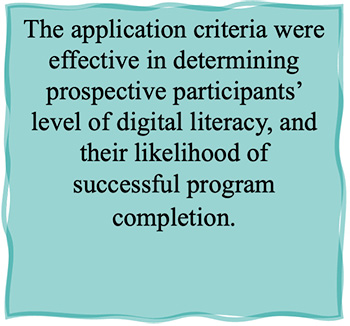
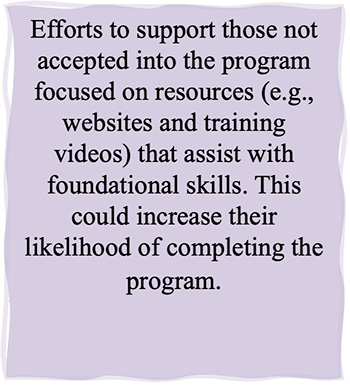 
Recommended Steps for Implementation
The figure below presents a flow diagram that shows the six steps of broadband facilitation with considerations for implementing a digital literacy Extension program.
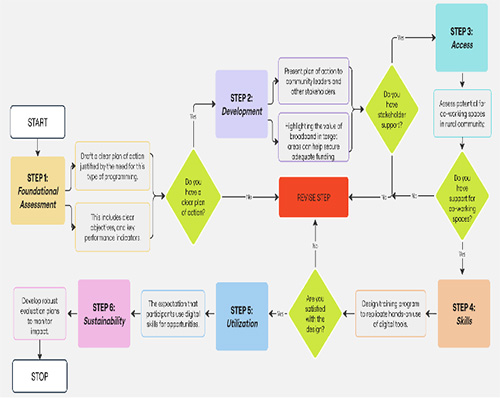
II. Utah State University Extension's E-commerce Service for Rural Businesses
Amanda D. Ali, Dominic C. Bria, & Paul A. Hill
Utah State University
Need for E-commerce Programming in Rural Utah
In rural Utah, small businesses experience low economic prosperity, financial instability, lack of skilled IT professionals, and low economic diversification because of limited access to resources (U.S. Chamber of Commerce, 2019; Surya et al., 2021). Although 72% of the rural population benefit from broadband internet (U.S. Chamber of Commerce, 2019), 66% of rural small businesses reported poor internet and mobile connectivity negatively impacted their business, 38% indicated a lack of access to skilled professionals to assist with digital tools, and 41% opted for programs that integrated digital tools into daily workflow and operations (U.S. Chamber of Commerce, 2019). To address some of these concerns, the Utah Legislature appropriated funding to USU Extension to develop a mentoring e-commerce service for small businesses in rural Utah communities.
USU Extension’s Ecommerce Accelerator (ECA) Mentoring Service
The ECA, through the introduction of digital tools and implementation of e-commerce business strategies, sought to enhance the overall economic well-being of rural small businesses by increasing sales revenue. Rural small businesses that sell products online can benefit from increased market access, expanded customer base, and improved competitiveness, leading to potential business growth and sustainability. The ECA is a hybrid six-week mentoring service that provides personalized training and support to small agricultural businesses interested in navigating the digital landscape. Two business consultants work with businesses to create an e-commerce enabled website. The structure curated for successful website development over the six weeks includes:
● Business assessment
● Customized website development
● Cross-platform Application Integrations (APIs)
● Online Marketing of Website
● Search Engine Optimization (SEO)
● Performance Monitoring and Optimization
Preliminary Results
During January - August 2024, the ECA successfully helped 12 small businesses develop fully functioning sales websites. All 12 participants reported increased confidence in e-commerce and had positive intentions toward maintaining their e-commerce strategy. Eleven participants perceived increased skills toward e-commerce, and at the time of completion, 5 reported increased sales revenue via their website. When asked about challenges moving forward, participants noted the cost of hiring qualified external help, trust and privacy concerns, and having sufficient resources to maintain their website on their own.
Reflections and Lessons Learned
 
 
 
 
 
Recommendations for Replication
The ECA offers a scalable solution for enhancing digital capacity for small rural businesses. The service’s success, evident in high satisfaction rates and increased sales revenue, demonstrates the potential for similar initiatives in other rural regions. Addressing ongoing challenges, such as resource allocation for website maintenance and cybersecurity will be important for continued success. The figure below provides a foundation for future e-commerce extension programs to build upon, ensuring economic growth in rural communities over the long term.

References
Surya, B., Menne, F., Sabhan, H., Suriani, S., Abubakar, H., & Idris, M. (2021). Economic growth, increasing productivity of SMEs, and open innovation. Journal of Open Innovation: Technology, Market, and Complexity, 7(1), 20. https://doi.org/10.3390/joitmc7010020
U.S. Chamber of Commerce. (2019, March). Unlocking the digital potential of rural America: A U.S. Chamber Technology Engagement Center (C_TEC) study commissioned by Amazon. americaninnovators.com
III. Utah State University Extension Partners with Montana to Form Environmental Justice Resource Center
Paul Hill, Ph.D. Austin Holmes
Utah State University Extension
Utah State University (USU) Extension, in collaboration with Montana State University, has launched a new Environmental Justice Resource Center as part of the Mountains and Plains Thriving Communities Collaborative (MaPTCC). This center, a participant in the EPA’s Environmental Justice Thriving Communities Technical Assistance Center (EJ TCTAC) Program for Region 8, supports communities in Utah, Colorado, Wyoming, Montana, and the Dakotas. The primary objective is to bridge the gap between federal and state funding and disadvantaged communities by offering technical assistance for environmental and energy justice projects.

Under USU Extension’s Rural Online Initiative, Austin Holmes leads this effort in Utah as USU’s community resource and engagement specialist. The center provides support for grant identification, project planning, and funding management, with emphasis on environmental remediation, clean energy development, air and water quality, and food security, particularly within underserved populations.
MaPTCC collaborates with entities including the Alliance for Tribal Clean Energy and various universities. With a focus on sustainable, community-driven solutions, the center addresses key regional issues and offers free expert assistance to organizations, including those from Tribal Nations and rural areas. For more information or to seek assistance, visit the MaPTCC website montana.edu/thrivingcommunities or contact Austin Holmes at [email protected].
NACDEP Recognition Committee - Fall Newsletter
Submitted by Eric Walcott
Michigan State University
Distinguished Career Reflection
By Brian Raison (2024 awardee)
By definition, a “distinguished career” award can be achieved only if (first) one has a career, and then you make it distinguished. But how do you do that?
If I might suggest one idea…
Have a mentor. Or better, have several.
Our young people and early career folks want to make a difference. In truth, at any age or career stage, we work in community development so we can make a positive impact in this world. And the best way I’ve found to enhance our ability is to have a mentor. (The research bears this out.)
If I may, I’d like to give you a challenge to consider: Get a mentor. Then, become a mentor to someone else.
Mentors need do only two things: encourage and challenge. Both are necessary. They work together. And anyone can do it. All you need is to give a small amount of time. That investment can change someone’s life… and subsequently impact their community… and our world. No exaggeration.
I am an unlikely professor. I am an unlikely advanced degree holder. I’m an unlikely award-winner. I am an Appalachian kid who never had a vision of much beyond the hills of Southern Ohio. But I was blessed with a number of mentors that encouraged me and challenged me. They changed my life. They made my career possible.
I implore you: Go do that for someone. Go encourage and challenge. Go help someone become more than they thought possible.
Excellence in Community Development Team: NH Housing Academy: creating local solutions to address the housing crisis in NH.
By Suzanne Cagle
The Housing Academy program was developed by UNH Extension with NH Housing Finance Authority as part of the InvestNH Housing Opportunity Grant Program. Recognizing that there is no one solution that is the right fit for every community and that local involvement and support is essential for sustained change, the goal of the program was to build the capacity of communities to effectively engage their community members to identify and implement locally supported solutions.
Housing Academy incorporated virtual and in person sessions designed to be interactive, encourage connections between communities and resource and support organizations. Topics covered included:
- Understanding the housing crisis
- Using data
- How to talk about housing
- Envisioning communities with more housing options
- Community engagement beyond public meetings
- How to make change – working with opposing views and mapping out regulatory change
- Bringing new people and voices into the housing discussion
The series was offered three times in 2023 with over 150 participants representing 64 communities. Extension offered technical support for communities as they developed and implanted their engagement plans and provided ongoing educational and networking opportunities and a virtual platform for resource sharing and collaboration.
While impact on the available housing market takes time and participating communities are at various points in the process, many towns have begun to implement zoning, regulatory, and systems changes to promote creative housing solutions for their communities. Due to the success of the initial program, state and local partners have continued to fund and support the program for an additional two years.
Excellence in Community Development Individual: Developing a County Strategic Plan using a Community-Centered Approach
By Peyton Beattie
Hello, NACDEP friends!
My name is Peyton Beattie, and I began my journey in NACDEP when I was the Community Development Extension agent with UF/IFAS Extension in Clay County. I recently started a new position at the University of Florida where I will spend 80% of my time developing, delivering, and evaluating professional development programs for Extension faculty in Florida and 20% of my time teaching an undergraduate level Extension course and advising Extension education master’s and PhD students. I have enjoyed being a part of NACDEP, and I don’t plan to stop being involved while taking on this different, campus-based role!
I joined NACDEP when I started my community development Extension agent position in the fall of 2021. Since then, I have attended the three NACDEP conferences in Indy, Cour d’Alene, and Houston. I tell every Extension related person that they must experience a NACDEP conference at least once – they will then be back for more! I have presented three presentations based on my community development work between the 2023 and 2024 NACDEP conferences. I have also been awarded runner-up for the NACDEP Educational Technology Award in 2023 and the NACDEP Excellence in Community Development Award in 2024. The Excellence in Community Development Award was awarded based on my work with Clay County government colleagues as we developed the first-ever county strategic plan using a community-centered approach. I look forward to continued engagement in and service to NACDEP!
NACDEP is Seeking New Officers: Spread the Word
Submitted by Crystal Tyler-Mackey
Past President
Participatory democracy is part of our NACDEP community development definition. We want to model that value through vibrant organizational culture.
Nominations, including self-nominations, are open for following six positions to be elected this fall:
- President-elect: three-year rotation, including also president and past president
- Treasurer: two-year term
- Western Region Rep: two-year term
- North Central Region Rep: two-year term
- 1890 Rep: two-year term
- 1994 Rep: two-year term
Learn more about officer responsibilities at https://www.nacdep.net/other-resources or by reaching out to Dr. Crystal Tyler-Mackey, Immediate Past President, at [email protected] or other members of the current officer team. Look out for an email to the full membership this month!

News from the North Central Region
Jan Steen
Kansas State Research and Extension
NACDEP North Central Region Representative
Our summer quarterly meeting this year was held on August 15th. We had a lot of useful information shared with participants about programs happening in the region, along with news and resources from the NCRCRD.
Work has been progressing on plans for our November 14th meeting where we’ll hear about the International Association for Community Development (IACD). Dr. Hunter Goodman from University of Arkansas Extension, and Holly Scheib from the IACD will present about the work they are doing in that association and how it aligns with what’s happening over here in NACDEP. We’ll also have updates from NACDEP leadership, the NCRCRD, and an opportunity for networking. If you’re in the North Central Region and did not receive the link on how to register for this meeting, please let me know via email and I’ll send you those details: [email protected].
NACDEP-NCR Newsletter Fall 2024
Submission from NCRCRD
NCRCRD October Webinar
Please join us for our next webinar, “Incorporating AI into Housing and Community Development,” on October 17 at 2 pm ET. We will explore two projects underway in the North Central Region that integrate Artificial Intelligence (AI) to address critical community issues.
Presentations in this webinar:
- AI-Driven Detection and Mapping of Manufactured Housing Communities
Armin Yeganeh, Michigan State University and NCRCRD Fellow
- Exploring the Potential Role of AI in Community Development
Lisa Bates and Christopher J. Seeger, Iowa State University Extension and Outreach
Learn more and register for October Webinar: https://bit.ly/3TodabA
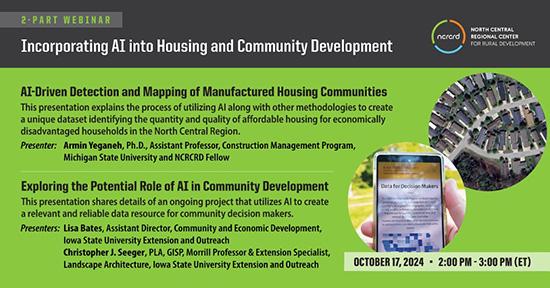
NCRCRD 2025 Grant RFPs Now Available
NCRCRD’s grant program supports new and ongoing regional research, Extension, and integrated activities and enhances the ability of the North Central Region’s thirty-four land-grant institutions to positively influence the quality of life in the region’s rural areas.
For more information, please visit: bit.ly/3eDMKBm
A Community of Practices Resources Feast
Submitted by Michael Dougherty
WVU Extension
The Land Use Planning Community of Practice (CoP) board of directors will be holding a professional networking opportunity
The 90-minute virtual session is Wednesday, October 23, 2024, at 2 p.m. ET (1 p.m. CT, 12 noon MT, 11 am PT). Pre-registration is required: https://usu-edu.zoom.us/meeting/register/tZcoduuuqD4tHdfbj7PjEh3KpnRkuTacVJ0Y
Extension educators working on land use and related topics from across the nation are invited to participate. This will be an opportunity to share your favorite land use, planning, or related resource (i.e., website, book, factsheet, handbook, etc.), build your national network, and enjoy a delicious feast of resources to help improve your work!
The Resources Feast will be a casual, informal online networking event – Join from the office, home office, campervan, or cabana!
Join the feast – We look forward to seeing you at the table!
The Land Use Planning Community of Practice (CoP) is a NACDEP Working Group. It provides timely and relevant information to individuals and extension professionals interested in land use issues and sustainable and resilient community planning and zoning. For additional information, please visit the following web site: https://www.nacdep.net/land-use-cop
A Methodology for Illustrating Labor Market Trends
by Fernando Quijano
Community Economics Educator, University of Minnesota
The paper described here contributes to the understanding of labor markets by showing how the Current Employment Statistics (CES) database can be illustrated to show dramatic trends in the relationship between employment, wages, and hours worked in many sectors, subsectors and occupations of a state’s economy. The CES data is maintained by the Bureau of Labor Statistics (BLS) for each state. This study focuses on the data for Minnesota, but the same methodology can be replicated in other states.
Communities and businesses looking to attract workers are the main target audience, but the content is relevant to anyone interested in the analysis of markets. The illustrations show how labor markets react to changes in supply and demand factors that in turn explain fluctuations in employment and wages. The figure below is an illustration in the paper that shows the employment-wage relationship for key industries of the Minnesota economy over the long term.
One version of the complete paper, written in collaboration with a state official, called Picture This: Labor Market Dynamics through Business Cycles and Industry Shifts was published just two weeks ago, in the September issue of Economic Trends, the quarterly journal of labor economics published by Minnesota's Department of Employment and Economic Development.
That version is a bit more complex than the version I usually present in front of live audiences, which is a dynamic PowerPoint presentation where industries appear one at a time on the screen and rigorous analyses can be discussed with the audience.
How is this information useful to clientele?
Industry analysts, job searchers, and communities in general can use this information to inform themselves about the level of wages currently and historically paid in particular industries. This is important information in a variety of contexts. For example, businesses often complain that they can't find workers, and we suspect that one of the reasons is that they don't have a clear understanding of wage trends in their industries or in related sectors. For example, a comparative analysis of the wages paid by durable and non-durable goods manufacturers reveals only a small difference between the two. This means that by offering only one or two more dollars per hour, one sector can steal workers from the other. This is an important factor in today's chronic shortage of labor throughout the economy.
Another way of using the data is to spark a conversation dealing with the suspected reasons for the patterns revealed by the data and unique variations in employment and wages across occupations. For example, notice how most industries tend to cluster around a tight range of employment values, meaning that industry employment does not fluctuate wildly but tends to remain stable within a certain range of values for most industries. The differences in how the pandemic affected industries can also be observed. The leisure and hospitality industry bears the brunt of volatility due to the pandemic, losing nearly 200,000 workers in the course of just a few months! The figure also shows that construction pays the highest wages among the occupations shown, but there are reasons, such as risk and sacrifice, that explain why those workers earn more than someone in the retail industry. Also notice how the industries that hire most workers (retail trade and leisure and hospitality) also pay the lowest wages.
In general, the reader can see how this data lends itself to all kinds of interesting analyzes, including the observations made by econometricians and statisticians, Thomas, concerning the distribution of data points on the upper and lower ranges of the scatter plot.
If you read the paper we wrote for the journal, you can see a great variety of directions in which this data can be understood and presented, but more importantly, that paper emphasizes the applications that fit nicely within the theoretical framework of the market system and how the employment wage space is indeed a supply and demand framework, with quantity (employment) along the horizontal axis and price (wages) along the vertical axis. Using a supply-demand analysis is very comforting when you talk to economists about this work.
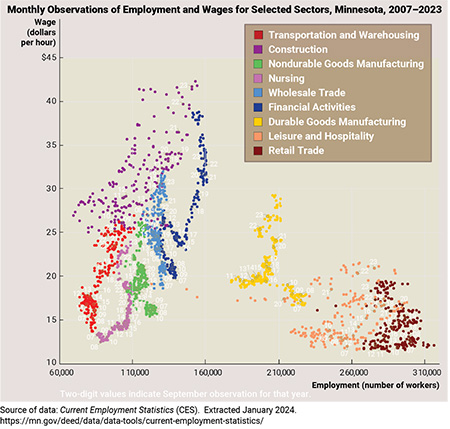
How can we use this approach in Extension?
I combine this analysis with the larger framework of "welcoming communities" and the idea that in the current workforce landscape it is important to offer not only appropriate wages in order to attract workers, but also a way of life that includes complementary housing, childcare, schools, diversity of goods, services and people, and inclusion of all groups in community discussions of culture and quality of life issues.
DEI In CD Conversation: October 25th
Submitted by Lisa Hinz
University of Minnesota Extension
Good conversation is always on the agenda at NACDEP's DEI in CD conversations so if you're free, drop into the next one on Friday, October 25th. at 1 p.m. ET, 12 pm CT, 11 am MT, and 10 am PT. Lisa Hinz and Amber Twitty DEI committee are co-leaders of the conversation.
Join Zoom Meeting
https://us02web.zoom.us/j/85930066481?pwd=mRFk6Da3OFmcNnR1KExAtpQ4fvzQqb.1
Meeting ID: 859 3006 6481

Registration Open for the Spring 2025 Rural Grocery Transition Specialist Course
Submitted by Rial Carver
Kansas State University Extension
Supporting rural grocers in business transition planning is essential to keeping the benefits of hometown grocery stores in rural communities. The Rural Grocery Transition Specialist program trains and deploys resource professionals across the country to better serve rural grocers through business transitions.
- Who: This course is designed for Extension professionals, economic developers and other resource providers who support rural grocers and rural community vitality across the country.
- Participants will gain: Strategies for building relationships with grocery store owners and managers, understanding of transition planning and business valuation concepts, and tools to support grocery store transitions. In addition, participants will join a national network of professionals dedicated to supporting rural communities.
- Format: This course contains seven online modules that include homework assessments and interactive discussion boards paired with guided learning through four synchronous 1.5-hour virtual sessions.
Registration for the Spring 2025 cohort (Jan – April) is now open! Register today!

|